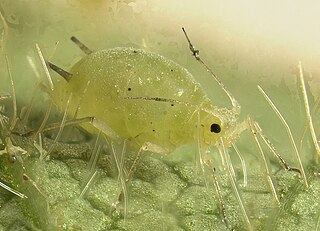
The Animal and Plant Health Inspection Service (APHIS) is an agency of the United States Department of Agriculture (USDA) based in Riverdale, Maryland responsible for protecting animal health, animal welfare, and plant health. APHIS is the lead agency for collaboration with other agencies to protect U.S. agriculture from invasive pests and diseases. APHIS's PPQ is the National Plant Protection Organization for the U.S., and the agency's head of veterinary services/veterinary Deputy Administrator is the Chief Veterinary Officer of the United States.

Although capable of living indoors with humans similarly to cats or dogs, pet skunks are somewhat of a novelty, and still relatively rare, mostly due to restrictive local and regional laws and the complexity of their diet, habits and care. The highest concentrations of pet skunks are mainly kept in the Canada, Germany, Italy, the Netherlands, Poland, and the United States.

Tigridia pavonia is a species of flowering plant in the iris family Iridaceae. Common names include jockey's cap lily, Mexican shellflower, peacock flower, tiger iris, and tiger flower. This summer-flowering bulbous herbaceous perennial is widespread across much of Mexico, Guatemala, El Salvador, and Honduras. It is naturalized in Ecuador and Peru.
Wildlife Services is the program intended to provide Federal leadership and skill to resolve wildlife interactions that threaten public health and safety, as well as agricultural, property, and natural resources. The program is part of the United States Department of Agriculture’s Animal and Plant Health Inspection Service (APHIS).

Aphis is a genus of insects in the family Aphididae containing at least 600 species of aphids. It includes many notorious agricultural pests, such as the soybean aphid Aphis glycines. Many species of Aphis, such as A. coreopsidis and A. fabae, are myrmecophiles, forming close associations with ants.

Coccinella transversalis, commonly known as the transverse ladybird or transverse lady beetle is a species of ladybird beetle found from India across southern and southeastern Asia to Malesia and Australia. It is not to be confused with Coccinella transversoguttata, a widespread species in Europe and North America also known as the transverse ladybird. The alternative vernacular of small transverse ladybird may be used for C. transversalis in instances where these two species are discussed together.

The black bean aphid is a small black insect in the genus Aphis, with a broad, soft body, a member of the order Hemiptera. Other common names include blackfly, bean aphid, and beet leaf aphid. In the warmer months of the year, it is found in large numbers on the undersides of leaves and on the growing tips of host plants, including various agricultural crops and many wild and ornamental plants. Both winged and wingless forms exist, and at this time of year, they are all females. They suck sap from stems and leaves and cause distortion of the shoots, stunted plants, reduced yield, and spoiled crops. This aphid also acts as a vector for viruses that cause plant disease, and the honeydew it secretes may encourage the growth of sooty mould. It breeds profusely by live birth, but its numbers are kept in check, especially in the later part of the summer, by various predatory and parasitic insects. Ants feed on the honeydew it produces, and take active steps to remove predators. It is a widely distributed pest of agricultural crops and can be controlled by chemical or biological means. In the autumn, winged forms move to different host plants, where both males and females are produced. These mate and the females lay eggs which overwinter.

Phytosanitary certification verifies phytosanitary worthiness. These certificates are used to attest that consignments meet phytosanitary import requirements and are undertaken by a National Plant Protection Organization (NPPO). Under the Agreement on the Application of Sanitary and Phytosanitary Measures and ISPM, a certificate for export or for re-export can be issued only by a public officer who is technically qualified and duly authorized by an NPPO.
Micraspis discolor is a species of ladybird. It was described by Johan Christian Fabricius in 1798. It is widespread throughout Asia, North America and parts of Oceania.

Lachninae is a subfamily of the family Aphididae, containing some of the largest aphids, and they are sometimes referred to as "giant aphids". Members of this subfamily typically have greatly reduced cornicles compared to other aphids, and the group has sometimes been classified as a separate family.

Aphis craccivora, variously known as the cowpea aphid, groundnut aphid or black legume aphid, is a true bug in the family Aphididae. Originally of probable Palearctic origin, it is now an invasive species of cosmopolitan distribution.

Aphis nerii is an aphid of the family Aphididae. Its common names include oleander aphid, milkweed aphid, sweet pepper aphid, and nerium aphid.

Aphis spiraecola is a species of aphid described in 1914 by Edith Marion Patch. Its common names include green citrus aphid, Spirea aphid, and apple aphid. It is distributed worldwide, and is most abundant in the United States. It has a diploid chromosome number of 2n=8.

Macrosiphoniella is a genus of aphids of the family Aphididae. The genus was described by Giacomo del Guercio in 1911. There are at least 150 described species in Macrosiphoniella.
A genetically modified sugar beet is a sugar beet that has been genetically engineered by the direct modification of its genome using biotechnology. Commercialized GM sugar beets make use of a glyphosate-resistance modification developed by Monsanto and KWS Saat. These glyphosate-resistant beets, also called 'Roundup Ready' sugar beets, were developed by 2000, but not commercialized until 2007. For international trade, sugar beets have a Maximum Residue Limit of glyphosate of 15 mg/Kg at harvest. As of 2016, GMO sugar beets are grown in the United States and Canada. In the United States, they play an important role in domestic sugar production. Studies have concluded the sugar from glyphosate-resistant sugar beets is molecularly identical to and so has the same nutritional value as sugar from conventional (non-GMO) sugar beets.
Pseudaspidimerus trinotatus, is a species of lady beetle found in India, Sri Lanka and Myanmar.











